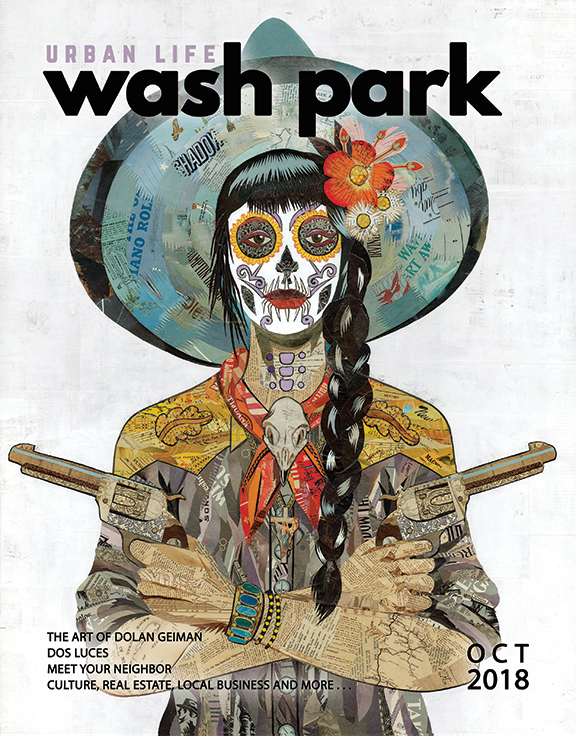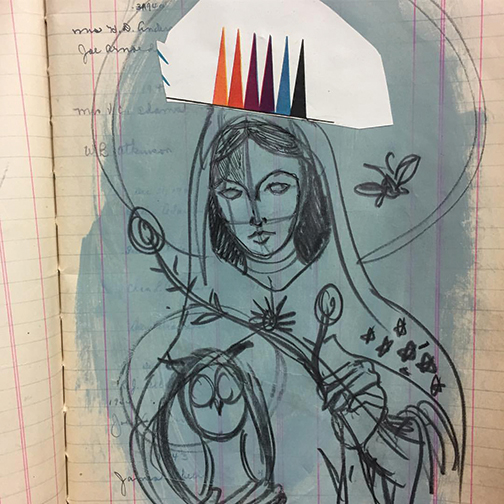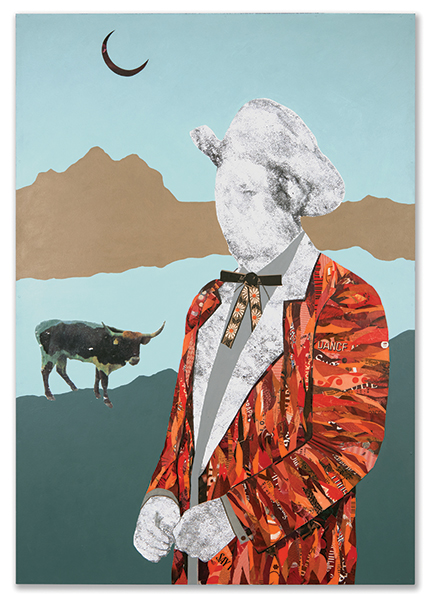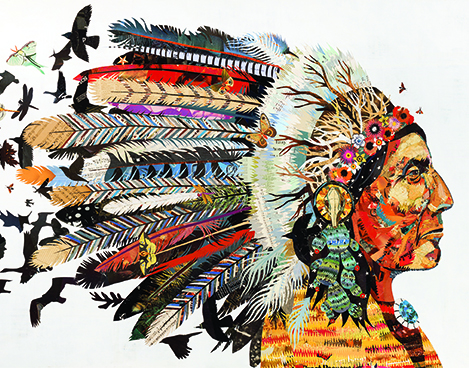BY MICHAEL ELLIS
To fully experience the work of local artist, Dolan Geiman, you must get up close and personal. Only when you are standing within a few inches of his creations, will you fully understand the magnitude and depth of his collages. This is not to say that his work can’t be enjoyed from a distance. Any way you approach one of his unique pieces, you are sure to step away from it with a fondness unlike any other.
 We have been fascinated by your work since we saw you at the Denver Flea. Can you tell us how you found yourself working full time as a visual artist?
We have been fascinated by your work since we saw you at the Denver Flea. Can you tell us how you found yourself working full time as a visual artist?
To answer this question, I’m going to drop you in the middle of the Shenandoah Valley of Virginia 30 years ago. To the left, you will see the foundation of an old wooden barn now a skeleton of what it used to be. Beside that there is a corn crib full of old corn cobs, wooden chairs, piles of broken whisky bottles, and metal advertising signs. To your right, you will see a large, brick colonial farmhouse built in 1796. Hand-hewn chunks of limestone resting below red clay bricks make up the foundation. If you look closely at the bricks, as I did on that day, you would notice that they contain small bits of quartz, gravel, rock, and shell. I pulled and scraped at the bricks until a small piece of shell came loose in my hand and then ran with it to my mother. My mind was expanding and tying itself in knots as it tried to figure out how the shell got into the bricks. My mother told me an old farm worker story. She described the women and men 200 years before me who dug deep into the creek, pulled up large chunks of thick muddy clay, packed the clay into rectangles, and then put them into a large oven. I couldn’t comprehend this type of creating entirely, but something ignited inside me and I became intensely interested in making something, anything. That summer and many summers after that, we smashed poke berries in big horse troughs and dipped T-shirts and skirts in the purple brine to create our own dyed fabrics. We constructed wooden mouse-trap-style games out of old wood scraps. We boiled old marbles on the stove until they cracked and made beautiful sun-catching prisms. Everything I did involved some type of creativity. My mother was never at a loss for new activities. When I was a little older, she started her own art career as a watercolor artist. She had taken a class at a local art center and the teacher was impressed. Her peers, however, weren’t convinced. “I’ve never seen a red tree, with blue leaves.” My mother just smiled and told them to look a little closer at nature. Thus began her career as the colorful watercolorist from the Valley. She participated in art fairs around the state and I went with her to help her set up her booth but mostly just to get in the way. Along the way, many of the things she did started to sink in. Through her sales she was able to put me through college and suggested I study art. During school, when I needed money, the first thing that came to my mind was “What can I make to sell?” I relied on my creativity because it was the one thing I possessed that set me apart from others. I had no second thoughts about selling my art. I had all the formal training I could ever want. After college, I switched gears a lot but always found avenues to sell artwork, whether on the street or in a gallery or at a friend’s office over a lunch break. I learned that if I treated my artwork as a business, I could figure out formulas for selling and creating that would last longer than a few months. And here I am!
 When you step close to one of your pieces, you realize the depth of the time and detail that go into each unique collage, or sculpture. How you decided on this medium and where do you find the materials for your collage works? How long does one piece take you from start to finish?
When you step close to one of your pieces, you realize the depth of the time and detail that go into each unique collage, or sculpture. How you decided on this medium and where do you find the materials for your collage works? How long does one piece take you from start to finish?
I decided on the medium of collage because I didn’t have money to buy ‘proper’ supplies like fancy brushes or even a canvas when I first started out. The paper I used then and still use today, comes from abandoned spaces–old farm houses, burned down buildings, abandoned gas stations, and the like.
One of my collages typically takes anywhere from a few weeks to a few months to complete. I also work on several pieces at a time, so I don’t fall too far into one particular piece and get, what I call, collage-blindness ( a unique form of artopethy where you think that the thing you are working on and have been completely immersed in for weeks is really fantastic until you finally step away from it and it looks like garbage).
There is a strong western vibe in your art. Being a boy from Virginia, what drew you to this aesthetic? Did it inspire you to come to Colorado?
I create my art like all poets and writers and musicians create their work: I move from place to place and try to make sense of the symbols, the theology, the trash and the treasure, and then I seek to create icons out of the myths and legends of these places using any material at hand.
Did it inspire me to come to Colorado? I don’t think so. I believe you move somewhere because you have to, because you love or hate people, because someone dies or leaves or goes away or is born, because you are sick of the city or because you are lonely in the country. It wasn’t inspiration that drove me to move here. I can be inspired by a stick in a bowl of soup. I moved to Colorado because I couldn’t spend any more time walking on concrete in the big city and because all of my artwork needed a place to grow. Plus I like to look at moving water and I like the fact that mountain lions still live here.
 The Denver art scene is so vibrant right now. Who are you most inspired by?
The Denver art scene is so vibrant right now. Who are you most inspired by?
To be honest, in order for me to make the type of work that I make and in order for me to have raw thoughts and ideas and to remain unique, I don’t look at a lot of other art and I don’t go to galleries or museums. I don’t go online. For me going to an art museum is like pulling up to a gas station with a full tank of gas. What’s the point? I do like writers though, and poets, and sometimes even musicians, in small doses. I always enjoyed how Richard Brautigan drew his inspiration from the rivers and mountains of Idaho and California, and I think about how his time spent writing there must have been quite beautiful. I always admired his writing style and his ability to see through society’s labels to strip a thing down to its essence, its raw nature. Of course then he blew his brains out in a cabin up there, so….go figure.
We attend Crush Walls every year and think one of your pieces would make a beautiful mural. Is this something you would ever consider?
It definitely sounds very cool and I’m not opposed to working on a wall or two. Sounds like a lot of great artists participate so it would be a honor to do it. I’m definitely nowhere near as good as a lot of mural artists that I have seen but I would give it a shot. I wonder if they’d let me do a giant collage?
 What advice can you give aspiring artists?
What advice can you give aspiring artists?
Drop out of school. School is a bubble that is too fragile for real artists. In school, I mainly learned that I should not have listened to most of my teachers. Sometimes teachers scare kids into losing their ambitions. We live in a society that tries really hard to pigeonhole kids, instead of letting them figure things out on their own. We’re way too protective and I think that totally screws you up. I spent five years in college fighting to retain my real creative ambitions. I tell people: if you have a good idea, and you think it’s a good idea, don’t ask anyone else
to agree with it. Just make it happen. If it’s good enough for you, it’s good enough to do. (Yes, that’s one of those grandpa rhymes.) Whether it’s traveling to Seattle to work on a program with some creative pals, hitchhiking to Utah, reading the entire encyclopedia, or building a raft and sailing down the Mississippi, just make it happen.
This isn’t to say I didn’t learn anything at all while I was in school, because I did learn how to use certain creative tools. However, the real part of being an artist is more than creating art in a classroom or learning how to use Photoshop. I learned from my mother, who was also an artist. I questioned businessman, financial advisors and figured out ways to double and triple my financial income especially as a creative artist. When I sold my art, I would ask myself “what do I do with my earnings? Do I apply to an art fair?”
Do I buy more supplies so I can create more art? A diploma isn’t everything because once you are done with school and you are an artist, the diploma doesn’t mean anything to someone in the art field. It’s your work they want to see, and your originality and work ethic.
Do you have any upcoming shows?
Come see me at Denver Flea’s Holiday Flea this December. I will also be hosting a private collectors event at my studio but would be happy to send an invite to Urban Life Wash Park readers. Send your address to hello@dolangeiman.com for an invite.

